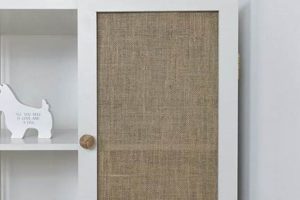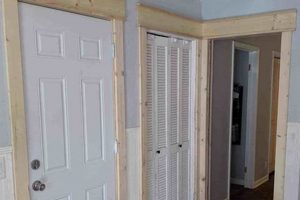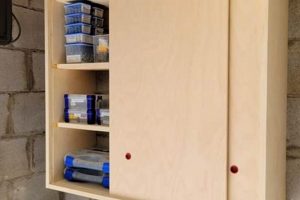Creating a concealed passage behind a functional piece of furniture, often a bookshelf, represents a unique approach to home design and space utilization. This project involves constructing a door that is visually integrated into the bookshelf, appearing as a normal section of shelving when closed, thereby concealing the entrance to another room or space. For example, a homeowner might use this to create a hidden home office or a secure storage area.
The appeal of such a design lies in its ability to maximize space, enhance security, and add an element of surprise and intrigue to a home. Historically, hidden doors and passages have been used for security purposes, safeguarding valuables, or providing escape routes. In contemporary design, the focus shifts to maximizing living space and creating unique architectural features.
The following sections will explore the key considerations in planning and executing this kind of project, encompassing structural design, material selection, hardware requirements, and finishing techniques necessary for a successful build.
Essential Considerations for Concealed Bookcase Door Construction
Successful integration of a concealed passage necessitates careful planning and precise execution. Attention to structural integrity and seamless visual integration are paramount.
Tip 1: Accurate Measurement is Crucial: Precise dimensions of the existing space and the intended bookcase are essential. Inaccurate measurements can lead to misalignment and functional problems, compromising the concealment.
Tip 2: Structural Support Reinforcement: The bookcase door will bear weight and experience frequent movement. Reinforce the frame and hinges to prevent sagging or instability. Steel reinforcements or heavy-duty hinges are advisable.
Tip 3: Hinge Selection and Placement: Concealed hinges offer a clean, seamless aesthetic. Select hinges rated for the weight of the bookcase and ensure proper alignment for smooth operation. Mortising hinges correctly is critical for functionality.
Tip 4: Consistent Material and Finish: Matching the materials and finish of the new bookcase door to the existing shelving is paramount for effective concealment. Source materials from the same supplier or utilize matching stains and paints.
Tip 5: Weight Distribution and Balance: Ensure even weight distribution within the bookcase to prevent uneven stress on the hinges and frame. Place heavier items closer to the hinge side of the door.
Tip 6: Locking Mechanisms: Implement a discreet locking mechanism for security. Magnetic latches or hidden bolts can provide secure closure without compromising the bookcase’s appearance.
Tip 7: Safety Considerations: Ensure the concealed passage is well-lit and ventilated. Install emergency release mechanisms to prevent entrapment within the concealed space.
These considerations are crucial for creating a safe, functional, and aesthetically pleasing concealed passage. Prioritizing these aspects ensures longevity and seamless integration within the existing environment.
With careful consideration of these points, the implementation of the project can be approached with confidence, leading to a successful realization of a concealed passage.
1. Precise measurements
Accurate dimensional planning constitutes a foundational element in the successful construction of a concealed passage disguised as a bookcase. A direct causal relationship exists between measurement precision and the overall functionality and aesthetic of the final product. Inaccurate measurements invariably lead to misalignment, rendering the concealed aspect less convincing and potentially impairing the door’s operational smoothness. For instance, a discrepancy of even a quarter of an inch can cause binding within the door frame, preventing flush closure and revealing the secret passage.
The importance of meticulous measurement extends beyond the initial frame construction. It permeates every stage of the process, from hinge placement to shelf installation. Correct hinge placement, dictated by precise measurements, ensures the door swings freely and aligns seamlessly with the surrounding bookshelves. Similarly, accurate shelf dimensions guarantee a uniform appearance, maintaining the illusion of a standard, unadulterated bookshelf. Practical application includes utilizing laser measuring tools and levels to ensure accuracy throughout the build. A detailed blueprint with documented dimensions is also crucial.
In summation, the construction of a concealed bookcase relies heavily on the accuracy of initial measurements. Challenges in this area can lead to functional impairments and compromised concealment. Recognizing this criticality is paramount for achieving a successful integration and realizing the intended design objective.
2. Reinforced structure
A reinforced structure forms an indispensable component in the realm of constructing concealed passages disguised as bookshelves. The inherent nature of this design entails supporting significant weight and enduring repeated use, necessitating structural enhancements that exceed those of a standard bookshelf. The absence of adequate reinforcement directly precipitates structural failure, manifested in sagging, warping, or complete collapse of the door mechanism. Such failures compromise both the functionality and the security of the concealed passage.
Reinforcement strategies encompass several critical elements. Utilizing solid hardwood, rather than particleboard or MDF, for the frame provides a robust foundation. Steel reinforcements, integrated within the frame itself, offer additional resistance to bending and twisting. Heavy-duty hinges, specifically engineered to bear substantial loads, are essential for smooth operation and preventing hinge failure. Consider a large bookcase door filled with books; without internal bracing and robust hinges, the weight would quickly overwhelm standard hardware, leading to misalignment and operational difficulties. These design considerations are paramount in ensuring a secure and functional hidden entryway.
In summary, a reinforced structure constitutes the cornerstone of a successfully implemented concealed bookcase project. Failure to prioritize structural integrity invariably results in operational deficiencies and compromised security. A thorough understanding of reinforcement principles, coupled with the application of appropriate materials and techniques, ensures the longevity and functionality of the disguised passage.
3. Concealed hinges
Concealed hinges represent a critical component in the successful execution of a concealed bookcase door project. Their function extends beyond mere connection; they are integral to maintaining the illusion of a standard bookshelf, a defining characteristic of this design.
- Aesthetic Integration
Concealed hinges allow for a seamless, uninterrupted surface on the bookshelf door when closed. Unlike traditional hinges that are visible and may disrupt the visual continuity, concealed hinges remain hidden within the door and frame, contributing to the overall aesthetic of secrecy. For example, SOSS hinges are often selected for their complete invisibility when the door is closed.
- Operational Smoothness
The engineering of concealed hinges frequently incorporates features that promote smooth and silent operation. These mechanisms are designed to minimize friction and reduce noise during opening and closing, further enhancing the discreet nature of the concealed entrance. High-quality concealed hinges often include adjustable components, allowing for fine-tuning of the door’s alignment and swing.
- Weight Capacity and Durability
Selecting concealed hinges requires careful consideration of the weight they are intended to support. Bookcase doors, especially those filled with books, can be substantial in weight. Therefore, hinges must be rated for the appropriate load to ensure long-term functionality and prevent sagging or failure. Heavy-duty concealed hinges, typically constructed from robust materials like steel, are necessary for such applications.
- Installation Precision
The effective function of concealed hinges hinges on precise installation. Mortising the hinges into the door and frame requires accuracy to ensure proper alignment and smooth operation. Improper installation can result in binding, uneven closure, or even damage to the hinges or surrounding wood. Specialized tools and templates can facilitate this process, ensuring accurate placement and mortise depth.
The selection and installation of concealed hinges are pivotal in achieving both the aesthetic and functional goals. Prioritizing quality and precision ensures a seamless integration within the larger design.
4. Matching materials
The congruity of materials used in the construction of a concealed bookshelf door is paramount to its success as a deceptive architectural feature. Disparities in material composition and finish compromise the illusion, immediately revealing the door’s true nature.
- Species Consistency
Employing the same wood species for both the existing shelving and the concealed door ensures consistent grain patterns and color undertones. Variations in wood type, even with staining, can lead to noticeable differences in texture and light absorption. For instance, if the existing shelves are constructed from oak, the concealed door should also utilize oak to maintain visual uniformity.
- Finish Synchronization
Achieving an identical finish on both the original structure and the newly constructed door is critical. This necessitates precise replication of the stain color, application technique, and sealant type. Differences in sheen, tone, or texture will immediately draw attention to the concealed door, negating its intended purpose. Trial and error on scrap wood is advisable to ensure an exact match.
- Hardware Harmony
Hardware elements, such as shelf supports or decorative moldings, must be consistent across both the bookcase and the hidden door. Using different styles, materials, or finishes for these elements will create a visual discontinuity that betrays the concealment. Attention to these small details is essential for a convincing illusion.
- Aging and Weathering Replication
If the existing bookcase exhibits signs of age, such as sun fading or minor wear and tear, replicating these effects on the concealed door enhances the realism. Techniques like distressing, antiquing, or controlled exposure to sunlight can help blend the new construction seamlessly into the existing environment.
The strategic implementation of carefully matched materials, therefore, moves beyond simple aesthetics. It is fundamentally intertwined with the core function of successfully integrating a secret door so that it remains virtually undetectable in its environment.
5. Balanced weight
Weight distribution constitutes a critical engineering consideration in the design and implementation of a concealed bookcase door. The structural integrity, operational smoothness, and long-term durability of the hidden passage are all directly contingent upon the balanced allocation of weight across the door structure.
- Hinge Stress Mitigation
Uneven weight distribution places undue stress on hinges, potentially leading to premature wear, sagging, or complete failure. A concentration of weight on one side of the door forces hinges to bear unequal loads, accelerating the deterioration process. Careful consideration of the materials placed on shelves, particularly heavier items such as large books or decorative objects, is imperative to prevent this stress. Equalizing weight minimizes strain and prolongs the lifespan of the hinge mechanism.
- Frame Integrity Preservation
An imbalance in weight subjects the bookcase door frame to torsional forces, leading to warping, cracking, or joint separation. These structural deformations not only compromise the functionality of the door, impeding smooth opening and closing, but also undermine the overall aesthetic of the concealed entrance. Centering heavier items and avoiding excessive loading on one side of the frame distributes the load more evenly, preserving the structural integrity of the frame over time.
- Operational Ease Enhancement
A properly balanced door requires less effort to operate, contributing to a smoother and more seamless user experience. A door with an uneven weight distribution may exhibit resistance when opening or closing, revealing its concealed nature through jerky movements or audible strain. Achieving balance ensures that the door swings freely and effortlessly, reinforcing the illusion of an ordinary bookshelf. A counterweight system, if implemented correctly, can further facilitate smooth operation by offsetting the door’s inherent weight.
- Floor Load Considerations
While weight is distributed within the bookcase, attention must also be given to the overall weight exerted on the floor. Concentrated weight from a heavily loaded, unbalanced bookcase door can exceed floor load capacity, potentially causing structural issues to the floor itself, especially in older buildings. Calculating the total weight and ensuring it is within the floor’s safe load limit is an important safety precaution. Reinforcements to the floor structure may be necessary in cases of exceptionally heavy loads.
In summation, the principle of balanced weight directly affects multiple facets of a concealed bookshelf door, ranging from the longevity of its mechanical components to the structural stability of the surrounding environment. Proper weight management is, therefore, an indispensable element in the successful construction and operation of this type of hidden passage.
6. Secure locking
The integration of secure locking mechanisms is a fundamental aspect of constructing a concealed bookshelf door. Without a robust locking system, the primary function of secrecy and security is severely compromised. The purpose of a hidden door often extends beyond mere novelty; it is intended to safeguard valuables, provide a secure room, or conceal an escape route. Consequently, the locking mechanism represents a crucial element of the design. The absence of secure locking negates the intended benefits, rendering the concealment superficial. For instance, a hidden panic room accessed via a bookshelf door would be functionally useless if the door could be easily opened by an intruder.
The selection and implementation of a secure locking system involve several considerations. The locking mechanism should be discreet, blending seamlessly with the bookcase’s aesthetic to avoid detection. Magnetic locks, hidden bolts, or disguised keypads are often employed. The strength and reliability of the chosen mechanism are paramount. A weak or easily bypassed lock provides a false sense of security. Furthermore, an internal release mechanism is crucial to prevent accidental entrapment within the concealed space. Real-world examples include incorporating a deadbolt lock accessible only from the inside, combined with a magnetic latch on the exterior, disguised as a decorative element on the bookshelf.
In conclusion, secure locking is not merely an accessory to a concealed bookshelf door; it is an intrinsic component that determines its effectiveness. The choice of locking mechanism, its integration into the design, and its operational reliability directly impact the security and functionality of the hidden passage. A well-designed locking system transforms a novelty feature into a practical and secure element of the home.
Frequently Asked Questions
This section addresses common inquiries and misconceptions surrounding the construction of concealed bookcase doors.
Question 1: What is the typical cost associated with a “secret bookcase door diy” project?
Project costs vary significantly based on factors such as material selection, door size, hardware quality, and the complexity of the design. A rudimentary project utilizing basic materials and standard hinges may range from $500 to $1,000. More elaborate installations incorporating premium hardwoods, concealed hinges, and custom locking mechanisms can easily exceed $2,000. Labor costs, if applicable, should also be factored into the overall budget.
Question 2: Are specialized skills necessary to undertake a “secret bookcase door diy” project?
Proficiency in basic carpentry is essential for the successful completion of this project. Familiarity with woodworking tools, accurate measurement techniques, and structural reinforcement principles is required. Expertise in mortising hinges, aligning door frames, and finishing wood surfaces is highly advantageous. Individuals lacking these skills may consider seeking professional assistance to ensure proper execution and structural integrity.
Question 3: How does the weight of the bookcase door affect the structural requirements?
The weight of the door, particularly when laden with books or other heavy items, directly influences the structural demands placed on the frame, hinges, and surrounding wall. Heavier doors necessitate robust framing materials, such as solid hardwoods, and heavy-duty hinges rated for substantial loads. Reinforcement of the wall studs may also be necessary to support the added weight and prevent sagging or instability. Failure to account for weight can lead to premature wear, operational difficulties, and potential structural damage.
Question 4: What are the primary safety considerations when designing a “secret bookcase door diy”?
Safety must be prioritized throughout the design and construction process. Emergency egress mechanisms, such as internal release latches or push-to-open mechanisms, are essential to prevent accidental entrapment. Proper ventilation within the concealed space is crucial to avoid air stagnation and potential health hazards. Electrical wiring should be installed by a qualified electrician to ensure compliance with safety codes. Furthermore, the door’s swing path should be carefully considered to avoid collisions or obstructions.
Question 5: How can the “secret bookcase door diy” be effectively concealed from casual observation?
Effective concealment relies on seamless integration with the existing environment. Matching the wood species, stain color, and finish of the bookcase door to the surrounding shelving is crucial. Concealed hinges, discreet locking mechanisms, and the absence of visible gaps or seams contribute to the illusion of a standard bookshelf. Careful attention to detail, such as aligning shelf heights and replicating decorative elements, further enhances the concealment.
Question 6: What type of locking mechanisms are appropriate for a “secret bookcase door diy”?
The selection of a locking mechanism depends on the desired level of security and discretion. Magnetic latches provide a simple and concealed means of securing the door, while deadbolt locks offer enhanced security for safeguarding valuables or creating a secure room. Keypad locks provide keyless entry and can be easily concealed within the bookcase design. The chosen mechanism should be robust, reliable, and easy to operate from both inside and outside the concealed space.
Careful planning, precise execution, and adherence to safety guidelines are paramount for a successful project.
The next section will cover design inspiration.
Concluding Remarks
This exploration of “secret bookcase door diy” has highlighted the crucial elements necessary for a successful endeavor. From the precision of measurements and the reinforcement of structure, to the selection of concealed hinges, the careful matching of materials, balanced weight distribution, and secure locking mechanisms, each aspect contributes to the functionality and aesthetic of the concealed passage. The complexities involved underscore the importance of meticulous planning and skillful execution.
As demonstrated, constructing a hidden passage behind a bookcase requires careful attention to detail and a thorough understanding of carpentry principles. Whether the intention is to create a unique architectural feature, enhance security, or maximize space, approaching the project with diligence and a commitment to quality craftsmanship will yield a rewarding result. The successful integration of a “secret bookcase door diy” not only provides a functional advantage but also adds an element of intrigue and sophistication to the home.







